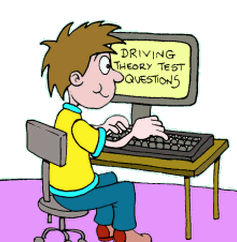The multiple choice theory test
This is the first part of the theory test, and is done at a computer rather than on paper. There are many places around the country whereby you are able to take the theory test. Your driving instructor will be able to tell you where the nearest locations are so that you can pick the one that is easiest for you to get to.
As the name implies, the purpose is to test that you understand the theory behind driving. This does not just mean knowing what different road signs mean: there is a comprehensive bank of questions covering a range of different topics that you should understand in order to fully appreciate driving theory.
The multiple choice part of the test for car drivers allows you 57 minutes to complete the test. The interface on the computer allows you to flag up questions that you are unsure of and want to come back to later. Therefore if you are unsure of a question rather than wasting too much time on it and potentially not having time to answer subsequent questions, you may like to flag and move on to further questions, then come back to questions you cannot do at the end.
The multiple choice element will ask you 45 questions. Fairly recently there is now a case study question in the test, that allows you up to 5 marks. So there is a total of 50 marks available. You must score 43/50 in order to pass, which equates to a score of 86%.
Please note that this information and site is geared purely towards the car driving theory test. The number of questions and time that is allowed for those driving other vehicles (e.g. buses and lorries) is different.
Related Articles...
Driving Theory Stopping Distances
Stopping distances refer to the distance that you car is going to travel from the time that you decide that you need to press the brake through the time that the vehicle physically stops...
Typical brake faults outlined
The brakes are a mechanical object and so it is possible that they will develop problems and not function the way that they should be. This is clearly very dangerous because brakes are one of the...
Working out what a road sign means
There are many signs that you will see day in day out as a driver and are obvious to understand. For instance signs that tell you the maximum speed limit on the road you're on. For some reason,...
Hazard Perception
There has been a significant increase in the focus of hazard perception and hazard awareness in the last few years since the introduction by the DSA of a separate hazard perception element to the...
Things to look for when checking tyre condition
The tyres are extremely important elements of the car, yet many people do not think much about them when checking that their vehicle is roadworthy.
However, in addition to checking the amount...
What is driving test theory?
Theory is something we understand when it comes to maths or science. A theory is a prediction as to why something that has usually been observed to happen does happen, and scientists use theories...
Maintaining your car
It is essential that you look after your car and keep it in good condition. Not only is this paramount for your safety and that of other road users, but also it means that the longevity of your car...
The ABC of dealing with casualties
The ABC refers to how to treat casualties if you are involved in an accident but not injured, or indeed if you are at the scene where an accident occurs.
The A refers to the word airway. This...
Risks when driving: bright or low sun
When the sun is low and bright, it can be very hard indeed to drive. This is because we may have to squint and the bright light can make it hard to pick out objects and to see, sometimes right in...
Speed limits on motorways
The speed limits on the motorway are something that you will no doubt be aware of for cars, but is the limit the same for a motorbike? And what about if you are bus or a coach driver?
Another...
Back to home page of driving theory test questions

